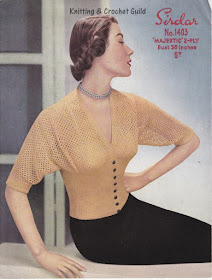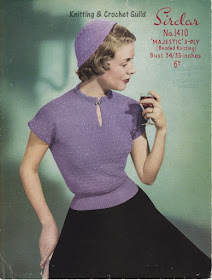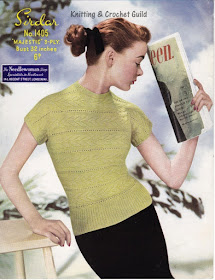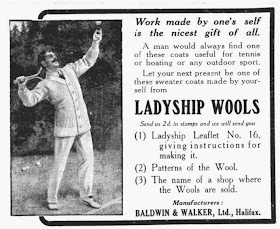The show had a resident panel of two men and two women, plus a presenter, and in each round, three people would come on, all claiming to be the same person. The panel had to decide which of the three was genuine. In the last round of the final show, three men came on stage, all claiming to be James Norbury. (You'll find this round starting at 19min. 19sec. - unless you want to start slightly earlier and watch the ads for Pepto-Bismol and Unguentine )
The presenter read a short piece about the real James Norbury: "I, James Norbury, am an expert in the art of hand-knitting. For seven years I taught knitting on British television. I have written ten books on the subject, including the authoritative Encyclopaedia of Knitting. I am also chief designer for the world's largest firm of wool spinners.... I am an accomplished knitter myself. As a matter of fact, in cable-stitch circles I am known as the Dior of the knitting needles." In the middle of this, two models appeared, wearing outfits designed by Norbury. One was a "knitted playsuit. It features a crew neck with diamond motifs and little-boy shorts." The other was truly atrocious: a "marine blue at-home ensemble with a crochet-accented button-front tunic over knee-length bloomers." It had a waisted tunic with flared skirt, mid-thigh length, revealing the bloomers and their deep lacy edging. I think that's "at-home" in the sense that you wouldn't want to be seen in public in it.
 |
| James Norbury on "To Tell the truth" |
Then the panel had about half a minute each to put questions to the three James Norburys. The answers didn't seem very informative, except that one panellist asked the real James Norbury "What is the difference between knit and purl?" and got the reply "Knitting is done with the wool at the front of the work and purling with the wool at the back of the work," which must have been a slip of the tongue, because it's clearly the wrong way round. So when the panel came to vote on who they thought was the real James Norbury, two picked the right man, but two picked a man who turned out to be an "expert in the art of yoga". The yoga expert seemed very outgoing, just the sort of person to present a TV series, and also managed to get in a mention of Patons and Baldwins.
And finally the presenter asked the question which has become a very well-known formula, even over here in Britain where no-one ever saw the show that started it: "Will the real James Norbury please stand up?"





























